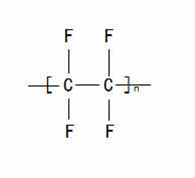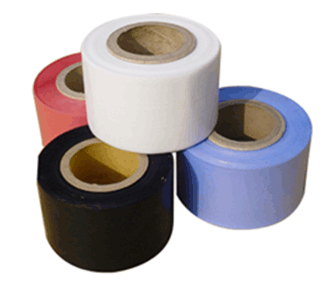Polytetrafluoroethylene (Polytetrafluoroethylene English abbreviated to Teflon or [PTFE, F4]) is called the "king of plastic", Roy Plunkett the father of fluorine resin in 1936 began to study the Freon substitutes in USA DuPont Co, they collected some tetrafluoroethylene stored in cylinders, ready for the next step of the experiment for second days, but when the second day open cylinder pressure relief valve, but no gas overflow, they thought it was flat, but the cylinder when the cylinder weighing, found not weight loss. They saw the cylinders, the white powder found a lot of, this is ptfe. Their study found that PTFE excellent properties, anti melting sealing washer can be used for the atomic bomb, shells, so American military will the technology have confidential during World War ii. Until after the end of World War II, to decrypt, and realize industrial production of polytetrafluoroethylene in 1946. Chinese commodity name "TEFLON", "TEFLON" (Teflon), "TEFLON", "special Fu Long", "TEFLON" etc.. It is composed of tetrafluoroethylene polymer by polymerization, its structure simple type to -[-CF2-CF2-]n-, with excellent chemical stability, corrosion resistance, corrosion resistant material is one of the best in the world, in addition to the molten metal and liquid sodium fluoride, capability of all the other chemicals in the aqua regia, boil is not change, widely used in a variety of needs in acid and alkali resistance and organic solvent. A seal, lubrication is not high viscosity, electrical resistance and good ageing resistance, temperature resistance excellent insulation (can work at +250 ℃ to -180 ℃ temperature for a long time) The use of temperature -190 ~ 250 ℃, allowing cold and heat, or alternating operation.

The chemical composition and basic introduction CAS No.:9002-84-0 EINECS number: 204-126-9 Molecular formula: (C2F4) n Molecular weight: 100.015612 Melting point: 327 ℃ [1] Boiling point: 400 ℃ Refractive index: 1.35

English Name: poly (tetrafluoroethylene); TETRAFLUOROETHYLENE OLIGOMER; TETRAFLUOROETHYLENE RESIN; TEFLON; TEFLON 7A; TEFLON (TM) 30B; TEFLON (TM) 6 (TM); TEFLON 7A; PTFE[2] Use of advantages High temperature resistant -- working temperature up to 250 ℃. Low temperature resistant -- with mechanical toughness good; even if the temperature dropped to -196 ℃, also can maintain 5% elongation. Corrosion resistance -- for most chemicals and solvents, inert, showed the ability of acid alkali, water and organic solvent. Weather resistant -- aging of plastics in the best life. High lubrication -- is a solid material in the lowest friction coefficient. No adhesion -- is a solid material in minimal surface tension, no adhesion to any material. No poison -- has physiological inertia, as artificial blood vessels and organs long-term in vivo without adverse reaction. Teflon high molecular weight, low for the hundreds of thousands, high amounts to ten million above, the general for the millions (degree of polymerization in 104 orders of magnitude, and the polyethylene only in 103). General a crystallinity of 90 ~ 95%, the melting temperature is 327 ~ 342 ℃. The CF2 unit of PTFE molecules in a zigzag shape, because the fluorine atom radius slightly larger than the hydrogen, so CF2 unit not adjacent completely according to trans cross orientation, twisted chains, but form a spiral, fluorine atom surface cover almost the entire polymer chain. The molecular structure to explain the various properties of polytetrafluoroethylene. The temperature was below 19 ℃, the formation of 13/6 spiral; phase transition occurs at 19 ℃, molecular slightly untied, forms the 15/7 helix. Although the fracture in the perfluorocarbon in carbon carbon and carbon fluorine bonds need to absorb the energy of 346.94 and 484.88kJ/mol, but the PTFE depolymerization generate 1mol tetrafluoroethylene only energy 171.38kJ. So during pyrolysis, depolymerization of PTFE mainly for tetrafluoroethylene. PTFE in 260, 370 and 420 ℃, the weight loss rate (%) per hour were 1 × 10-4.4 × 10-3 and 9 × 10-2. Visible, PTFE can be used for a long time at 260 ℃. Due to the high temperature cracking also produce toxic by-product fluoro phosgene and perfluoroisobutylene, so be very Caution! Protection and to prevent contact with open flame ptfe. Chemical property Corrosion resistance: resistance to radiation performance and low permeability: long-term exposure to the atmosphere, surface and performance remains unchanged. Incombustible: limiting oxygen index below 90. Acid and alkali resistance: not soluble in strong acid, strong alkali and organic solvents (including magic acid, namely fluoroantimonic acid). Antioxidation: corrosion resistance strong oxidant. PH: neutral. Material properties Density: 2.1 - 2.3 g/cm3; The mechanical properties of PTFE is soft. Have a very low surface energy. Polytetrafluoroethylene (F4, PTFE) has a series of excellent performance: high temperature resistance, long-term use temperature of 200~260 degrees, -100 degrees low temperature resistant, corrosion - resistant still soft; aqua regia and all organic solvents; aging life the best climate - Plastics; high lubrication, has the lowest friction coefficient in plastics (0.04); not viscous solid materials in the minimal surface tension without adhesion to any material; no poison - has physiological inertia; excellent electrical properties, is C ideal insulation material, the newspaper with a thick layer of can prevent 1500V high voltage; more smooth than ice. PTFE material, widely used in national defense and military industry, atomic energy, petroleum, radio, electric machinery, chemical industry and other important sectors. Products: PTFE ethylene tube material, four bar, sheet, turning plate. Mechanical properties The minimum coefficient of friction of it, only the 1/5 of polyethylene, which is an important characteristic of perfluorocarbon surface. Because the fluorine - carbon chain intermolecular force is very low, so the PTFE has no viscosity. PTFE maintain excellent mechanical properties at -196 ~ 260 ℃ relatively wide temperature range, one of the characteristics of fluorocarbon polymer is in low temperature invariant crisp.
Weather resistance and chemical resistance PTFE has high resistance to chemical corrosion, such as sulfuric acid, nitric acid, hydrochloric acid, even after Wang Shuizhong boil, no change in its weight and performance, almost insoluble in most solvents, only in 300 ℃ above slightly soluble in total alkane (about 0.1g/100g). PTFE does not absorb moisture, non flammable, are very stable to oxygen, ultraviolet, so excellent weather resistance. Electrical properties PTFE in a wide frequency range the dielectric constant and dielectric loss are very low, and the volume resistivity and breakdown voltage, arc resistance are higher.

The radiation resistance PTFE radiation resistant performance is poor (Ladd, 104) by high-energy radiation induced degradation, electric performance and mechanical properties of polymer decreased significantly. Polymerization PTFE by tetrafluoroethylene by free radical polymerization of generation. Polymerization industry is in the presence of water stirring, to disperse the heat of reaction, and easy to control the temperature. Polymerization is in commonly 40 ~ 80 ℃, 3 ~ 26 kg / cm 2 pressures, through organic peroxides, inorganic sulfate can be used as initiator, can also be caused by oxidation and reduction system. Per mole of tetrafluoroethylene polymerization exotherm 171.38kJ. Dispersion polymerization to add surface active perfluorinated agent, e.g. perfluorooctanoic acid or its salts. Expansion coefficient (25 ~ 250 ℃) 10 ~ 12 × 10-5/ ℃ PTFE sintering process Molding shrinkage rate: 3.1-5.0% The molding temperature: 330-380 ℃ The best sintering condition: temperature should not exceed 385 degrees, otherwise molecules necrosis, affecting the quality of. Sintering process: the critical pressure of the pure PTFE material is about 27.5 MPa, compression strength of PTFE material pressure increases; compression modulus with the pressing pressure increasing. The molding pressure of PTFE for 27.5 MPa. The sintering process was determined as follow: the sintering temperature is 380 ℃, holding time of 4 h, the heating rate of 200 ℃ to 80 ℃ / h, 200 ℃ of 60 ℃ / h, cooling rate and cooling in the furnace. Material properties 1 long-term use temperature -200--260 degrees, have excellent resistance to chemical corrosion, to all chemicals are corrosive, the lowest friction coefficient in the plastic, and good electrical properties, the electrical insulation from temperature effect, the "plastics king," said the. 2 a transparent or translucent, higher crystallinity, transparency is poor. Raw material is powdered resin or concentrated dispersions, molecular weight, high, high crystallinity of thermoplastic polymers. 3 suitable for making the corrosion resistance, wear resistance, sealing, insulation and medical equipment parts of 1 K) Forming performance 1 crystalline material, moisture absorption is small. The 2 poor liquidity, easy decomposition, decomposition of the corrosive gases. To strictly control the molding temperature, the mould should be heated, pouring system flow resistance of PTFE ethylene tube material Should be small. 3 powder resin used powder powder metallurgy forming, sintering method. The sintering temperature of 360-375 degrees, not more than 410 degrees. Emulsion resin usually use cold extrusion processing and sintering process, can form a coating on the surface of articles. If the required product transparency, good toughness, should take rapid cooling. Can also take the extrusion molding, extrusion tubes, rods, profiles can be. The melt viscosity of 4.PTFE is high, increasing the volume viscosity with shear stress decreases, showing the characteristics of non Newtonian fluid. 5 two processing, hot pressing, welding, can be bonded, enhancement, mechanical processing, in order to obtain the final product. 6 the best curve sintering The first step in the 120 degree dry The second step such as graphite or two curing ink in 250 degrees of temperature treatment. The third step in the 345 degrees at a time The fourth step process at 375 degrees The fifth step cooling not too fast
PTFE application PTFE can be compressed or extrusion molding; also can be made into a water dispersion, used for coating, dipping or fibres. Widely used as Teflon in the atomic energy, defense, aerospace, electronics, electrical, chemical industry, machinery, instrument, meter, construction, textile, metal surface treatment, pharmaceutical, medical, textile, food, metallurgical and other industries in the high and low temperature resistance, corrosion resistant materials, insulation materials, anti sticking coating,,. Which can not be substituted products. PTFE has excellent comprehensive properties, good resistance to high temperature, corrosion resistance, non stick, self lubrication, the friction coefficient of the dielectric properties, excellent low. As engineering plastics, can be made of Teflon tube, rod, strip, plate, film and so on, generally used in high performance corrosion of pipes, containers, pumps, valves and radar, high frequency communication equipment, radio equipment. Add any can withstand the sintering temperature of PTFE filler in PTFE, mechanical performance can be greatly improved, while maintaining the excellent performance of PTFE other. Varieties of filled with glass fiber, metal, metal oxide, graphite, MoS2, carbon Qianxian, polyimide, EKONOL... And so on, wear resistance, the limit PV value can increase 1000 times. PTFE application PTFE tubing using suspension polymerization of PTFE resin is manufactured by ram extruding method. In the known plastic PTFE has the best corrosion resistance and dielectric properties. PTFE braided packing is a good dynamic sealing materials, is made of expanded poly four vinyl tape woven, having a low coefficient of friction, wear resistance, chemical corrosion resistance, good sealing performance, no hydrolysis, not hardened and other excellent performance. Liner for various medium sealing and lubricating materials, as well as in various frequency of use of electrical insulation, capacitor dielectric, wire insulation, insulation, electrical instrumentation. The teflon film for capacitor dielectric, special cable insulation layer, wire insulation, electrical instrumentation insulation and sealing gasket, also do not tape, sealing tape, release, the sealing ring. In addition, non-stick cookware life using the lining also use PTFE production, is the use of PTFE, not sticky. Insulation class C 1 wire and cable insulation material; Sheath 2 dual water inner cooled turbogenerator stator and rotor diversion pipe and a thermocouple; Microwave 3 HF, UHF communications and radar equipment insulating material; 4 printing " |
